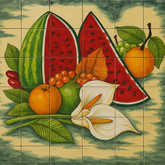Hand-Painted Fruit and Calla Lily Tile Mural
Infuse your space with natural elegance and traditional craftsmanship through the Hand-Painted Fruit and Calla Lily Tile Mural. This stunning 36-tile composition unites the vivid color palette of Mexican Talavera with the soft sophistication of botanical still life. The arrangement features juicy watermelon slices, ripe citrus fruits, green apples, and clusters of grapes—all grounded by two elegant white calla lilies. Painted entirely by hand using mineral glazes and finished with a glossy kiln-fired surface, this mural brings vibrant harmony and artisanal texture to kitchens, patios, and dining spaces inspired by rustic or Mediterranean design.
A Vivid Botanical Still Life
At the heart of this mural is a carefully balanced still life composition that celebrates both the bounty of nature and the traditions of Talavera tile painting. Central to the piece are thick slices of red watermelon, arranged to draw the viewer’s eye inward. These are flanked by a citrus orange and crisp green apples, while cascading grape clusters and touches of golden-yellow fruit provide contrast and energy. Two striking calla lilies unfurl at the bottom right corner of the scene, adding a sculptural quality that balances the roundness of the fruit.
The background is painted in a soft cream color, enhanced by hand-applied teal washes that suggest movement and airiness. Black outline work defines each element, from fruit skin to floral detail, enhancing the mural’s depth and character. The composition is framed not with borders but by careful use of negative space and foliage, which gives the entire mural a refined, organic aesthetic perfect for elegant rustic settings.
Traditional Craftsmanship and Talavera Heritage
Crafted in the renowned workshops of Dolores Hidalgo, each tile in the Fruit and Calla Lily mural is a product of generations-old Talavera artistry. This region is famous for its skilled ceramicists who preserve colonial-era techniques while adapting them to contemporary expressions. The tiles are first coated in a tin-based glaze, forming a bright surface that intensifies the vibrancy of hand-applied mineral pigments. The artisan paints each tile individually, ensuring natural variation in brushstroke and glaze distribution—a hallmark of handcrafted authenticity.
The mural comprises 36 square tiles, each measuring approximately 4x4 inches and forming a larger cohesive scene. Fired in high-temperature kilns, the tiles develop a durable, glossy finish with rich tonal layering. The overall effect is one of luminous color and subtle texture, ideal for focal points in hacienda kitchens, Mediterranean patios, or country-style dining rooms. With its graceful imagery and warm palette, this mural becomes not just decoration, but an emotional tribute to traditional Mexican still life painting.
Color and Design Details
- Watermelon: Deep red with black seeds and green rind
- Grapes: Rounded clusters in lush green tones
- Calla Lilies: Elegant white petals with orange pistils
- Foliage: Layered forest greens for texture and flow
- Background: Cream surface with soft teal washes
- Outline: Black lines define and add shadow
Stylistic Influences and Cultural Roots
The Hand-Painted Fruit and Calla Lily Tile Mural exemplifies the cross-cultural elegance of Mexican tile artistry. It borrows from Spanish Colonial realism, Mediterranean still life, and regional folk motifs. While the symmetrical arrangement and fruit symbolism echo traditional Catholic and rural Mexican themes, the inclusion of calla lilies introduces a refined, almost sculptural element. This blending of naturalism and cultural identity gives the mural depth beyond visual appeal—it becomes a reflection of life, beauty, and heritage.
Calla lilies are often associated with purity and devotion in Mexican art, making their placement alongside fruit symbolic of balance between nature’s sustenance and spiritual elegance. The result is a mural that conveys both everyday abundance and contemplative beauty. Whether placed in a rustic retreat or a bright indoor dining room, it commands attention while enhancing the atmosphere with subtle grace and artisanal richness.
Tile Specifications
- Total Tiles: 36 hand-painted ceramic tiles
- Tile Size: Approx. 4" x 4" each
- Material: High-fired ceramic
- Glaze Finish: Glossy with tonal variation
- Technique: Painted with mineral glazes
- Thickness: Around 1/4" (6–7 mm)
- Origin: Dolores Hidalgo, Mexico
- Theme: Still life with fruit and flowers
Perfect For
- Hacienda kitchen wall accent or backsplash
- Rustic-style dining area focal point
- Mediterranean or colonial-style patio alcove
- Restaurant or boutique café with artisanal decor
The Tile-Making Tradition of Dolores Hidalgo
Located in the heart of Guanajuato, Mexico, the town of Dolores Hidalgo holds a distinguished place in the world of ceramic artistry. While most visitors associate the town with its role in Mexico’s fight for independence, artisans and collectors know it as one of the birthplaces of hand-painted Talavera tile production. For centuries, Dolores Hidalgo has nurtured a tile-making tradition that blends Spanish colonial techniques, indigenous heritage, and regional creativity into a distinctive and celebrated craft.
The roots of tile production in this town go back to the 16th century, shortly after Spanish settlers arrived in Mexico and introduced new ceramic methods. Among these was the use of tin-based glazes—a technique brought over from Spanish cities like Talavera de la Reina and Seville. These glazes gave pottery and tiles a luminous, white surface ideal for painting. Over time, local artisans in Dolores Hidalgo adapted these European methods to reflect Mexican landscapes, symbolism, and folklore. The result was a ceramic art form that felt entirely local while maintaining a connection to its Spanish roots.
By the 18th and 19th centuries, tile production in Dolores Hidalgo had become both an economic engine and a cultural emblem. Entire neighborhoods were dedicated to pottery workshops, where generations of families painted and fired tiles by hand. These tiles adorned homes, churches, fountains, and public plazas, becoming a visual language that expressed both faith and everyday life. Floral motifs, religious icons, animals, and pastoral scenes were common themes—each interpreted through bold lines and vivid glazes.
One of the defining characteristics of Dolores Hidalgo tilework is its emphasis on handcrafting. Unlike industrial tile manufacturing, which relies on digital printing and uniform molds, the Talavera tiles from Dolores are made individually. Artisans begin with a base of clay, shaped and dried before undergoing the bisque firing process. Then comes the application of the traditional white glaze that serves as the painting canvas. Using fine brushes and mineral-based pigments, artists hand-paint each tile, often without stencils or guides. This ensures that no two tiles are exactly alike—a key mark of authenticity and craftsmanship.
The town's climate and geography have also played a part in shaping its ceramic industry. The local clay, found in abundance in the nearby hills, is ideal for firing and holds glaze well. The temperate climate allows for the air-drying stages that precede kiln firing, while regional access to natural mineral pigments has historically allowed for a broad color palette. Reds, blues, greens, and yellows are the most iconic, and artisans in Dolores Hidalgo have developed special recipes over time to achieve consistent brilliance and contrast.
Today, Dolores Hidalgo remains one of the few towns in Mexico that still produces Talavera tiles in the traditional way. While modern tools and kilns have been introduced, many workshops continue to honor centuries-old processes. It's common to walk through the town and find entire families involved in production—shaping clay in one corner, glazing tiles in another, and meticulously hand-painting fruits, flowers, and geometric patterns at sunlit tables.
The themes expressed in these tiles are a rich tapestry of Mexican identity. Some murals depict historical moments or Catholic imagery, while others focus on nature, agriculture, and culinary elements—like fruits, wine bottles, and native plants. These motifs reflect the rhythms of local life and serve as cultural documents rendered in ceramic form. They also allow for a high degree of personalization, making each mural not only a decoration but a story.
Whether displayed in a private residence, restaurant, or public space, a tile mural from Dolores Hidalgo carries with it more than color and composition—it brings the legacy of a town that has turned clay and glaze into a form of storytelling. Every brushstroke speaks of history, family, technique, and pride. For those who appreciate craftsmanship and cultural depth, Talavera tiles from this historic town offer more than decoration—they offer connection.
Bring This Mural Home
Add visual storytelling to your interiors with this stunning Fruit and Calla Lily Tile Mural. Hand-painted and infused with botanical charm, it transforms walls into galleries of regional artistry. Whether you're renovating a kitchen or designing a tranquil courtyard, this piece invites warmth, heritage, and refinement into any space.
To explore the mural in more detail or to make a purchase, visit the Fruit and Calla Lily Talavera Tile Mural product page. If you have any questions about installation or customization, feel free to contact our Mexican tile specialists.



